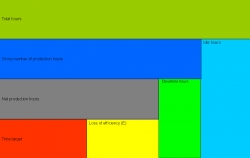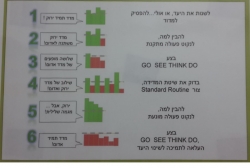The guiding principle behind our work leads a company to improvement and does not provide it with advice. We work this way for several reasons:
Firstly, we, as people, don't like to receive advice, and therefore, improvements in work methods that are obtained as external knowledge and not as a product of internal work, shall encounter opposition or will not be implemented in the long term.
There is a tremendous amount of valuable information within every company and some of it does not emerge in the form of information in the decision making and amelioration process. Ultimately, our objective is to create tools and work methods that will create constant improvement that does not depend upon our presence, and will continue for many years even after we have left the company.
So how does it work?
In every company, the administration is the forum which contends with emerging market challenges and opportunities. Management is a limited entity; on the one hand, its members are overloaded, and on the other hand, their capacity and creativity is limited and not boundless. Management focuses on the “main objective”, the decision makers establish priorities and for lack of choice neglect anything that is not considered the “main objective”. However, that same component, which is considered negligible, enables the collection of a great deal of money from the floor. Imagine that you can convert 5%-10% of expenditures into profits within several months and at the same time – as a direct outcome – connect employees to the company objectives, enhance motivation and breathe new spirit at all company levels.
There is a vast treasure of hidden knowledge and power of thought at levels below management that do not take part in the thinking process and do not cope with challenges.
At the initial stage of collaborative work, we shall identify the profit leverages.
Profit leverage is a topic or field, in which any small improvement in results leads to great improvement in profits.
We should keep in mind that every NIS 1,000 that we save on expenditure goes to profit.
When an improvement project is initiated in a company, the first task is to identify and agree upon profit leverages according to a set of priorities.
Sometimes it is decided to handle a competition factor, such as service, from a long term perspective and there is no focus on improving profit in the immediate term.
Profit Leverages handled via two corresponding routes:
-
In the first route, quantitative and measurable performance indicators are chosen, which help us obtain data for improvement and on the same time, to implement control over the amelioration process.
-
It is recommended to use standard performance indicators (normally called KPI's, which is means: "Key Performance Indicators) which are used in the international industry with the necessary adaptations for each specific company.
-
The performance indicators are measured and handled on a daily weekly or monthly basis at least.
-
In the second route we shall improve the results of the performance indicator.
-
The process is based on work in small teams of employees and on existing knowledge, both exposed and hidden.
-
This is how we expand the group that contends with the challenges facing the company and the quantity of knowledge that is incorporated within the existing knowledge base.
-
A significant portion of the acquired knowledge and knowledge that is created by the employees remains hidden. The employees do not share it with each other and do not pass it on to the higher echelons of management.
-
In meetings held with the CEO, the company executives and mainly with employees, we identify, in unison, several profit leverages in each dept.
-
The designated teams regularly monitor the completion of each target, firstly within each domain or division.
-
The head manager of the dept. (for instance, Marketing, Finance, Operations) is in charge of coordination this activity, monitoring the streamlining process, and providing feedback.
-
Once a month, the CEO coordinates a management meeting during which each Deputy CEO reports on how the division completed its targets and what was done to improve the process.
-
We would like to emphasize that this meeting must sum up the standard procedure for achieving targets which is conducted with the employees, including monitoring at least once a week.
-
In team work, when the proposals for improvement and the corrective action come from the employees, several advantages are obtained:
-
The employees provide the hidden knowledge, and the company benefits from a great deal of information that was not utilized.
-
The employees feel committed to implementing the steps that they proposed.
-
The employees' motivation is enhanced.
-
The aforementioned methods may also be employed in small teams and small companies.
Moving on to the presentation:
-
The first two slides present the hidden opportunities within the organization hierarchy.
-
The management (and sometimes even a most limited entity of a select few who are close to the CEO) copes with the internal and external challenges, gets as much done as possible, and there are always many subjects that are not covered.
This is where a significant amount of money can be collected from the floor.
-
Beneath the management are the levels of employees who do not contend with company problems and challenges.
If we would have them join [this circle] we would gain a great deal, and this is one of the topics of the lecture.
-
Slide 4 presents the importance of measurement to achieve improvement.
-
In slide 5 we shall define and choose the areas for improvement and we will become familiarized with profit leverages for the first time.
-
In slide 6 we shall define the profit leverages and how to choose them.
-
The following two slides present how to handle profit leverages. In the first circle, we shall choose the performance indicators for focusing and measurement and in the second circle to handle this process we shall add the employees through work in small task teams in order to induce amelioration.
-
In slide 9 we shall further elaborate on the work with the task teams and in the next slides we will specify the CEO's pivotal role in the improvement process.
-
In slide 11 we shall present how with the help of a monthly targets board, summing up the team work and arriving at the monthly executive board meeting, we can focus the entire management on the main company objectives and lead to improvement across the board within the organization.
-
In the following slides we shall present examples of indicators and work using this method.
-
We shall begin with Finance; we will present several indicators and demonstrate a sample of how several companies decreased customers’ debt to zero.
-
Slides 16 to 21 present Operations with several examples.
-
We shall begin by improving the machine performance by measurement, brief daily meeting on results of the day before, a weekly meeting of the task team and of course the management.
-
Some of the reasons for the low outputs were the long halts of the machines (preparations, start up, replacements, lack of operators and malfunctions). In slide 18, we shall see how in one of the companies they spurred significant improvement in the halted operation due to malfunctions.
-
Slide 19 presents improvement and savings of one million NIS over a short period of time with the help of 3 improvement teams who were engaged in reducing losses.
-
Slides 20, 21 deal with the accuracy of the inventory managing, the importance of measurement of this subject and handling results and how a great deal of money was saved in one of the companies.
-
Slides 22 to 24 present work in Marketing and Sales. How we shifted our focus in the right direction after a decline in sales over several years, and with the help of planning and work achieved a tremendous leap in sales performance.
-
At the end of the presentation we shall see photos of teams in action and in the final slide we shall display the link to the website.












 My First Book: Manage! Best Value Practices for Effective Management
My First Book: Manage! Best Value Practices for Effective Management